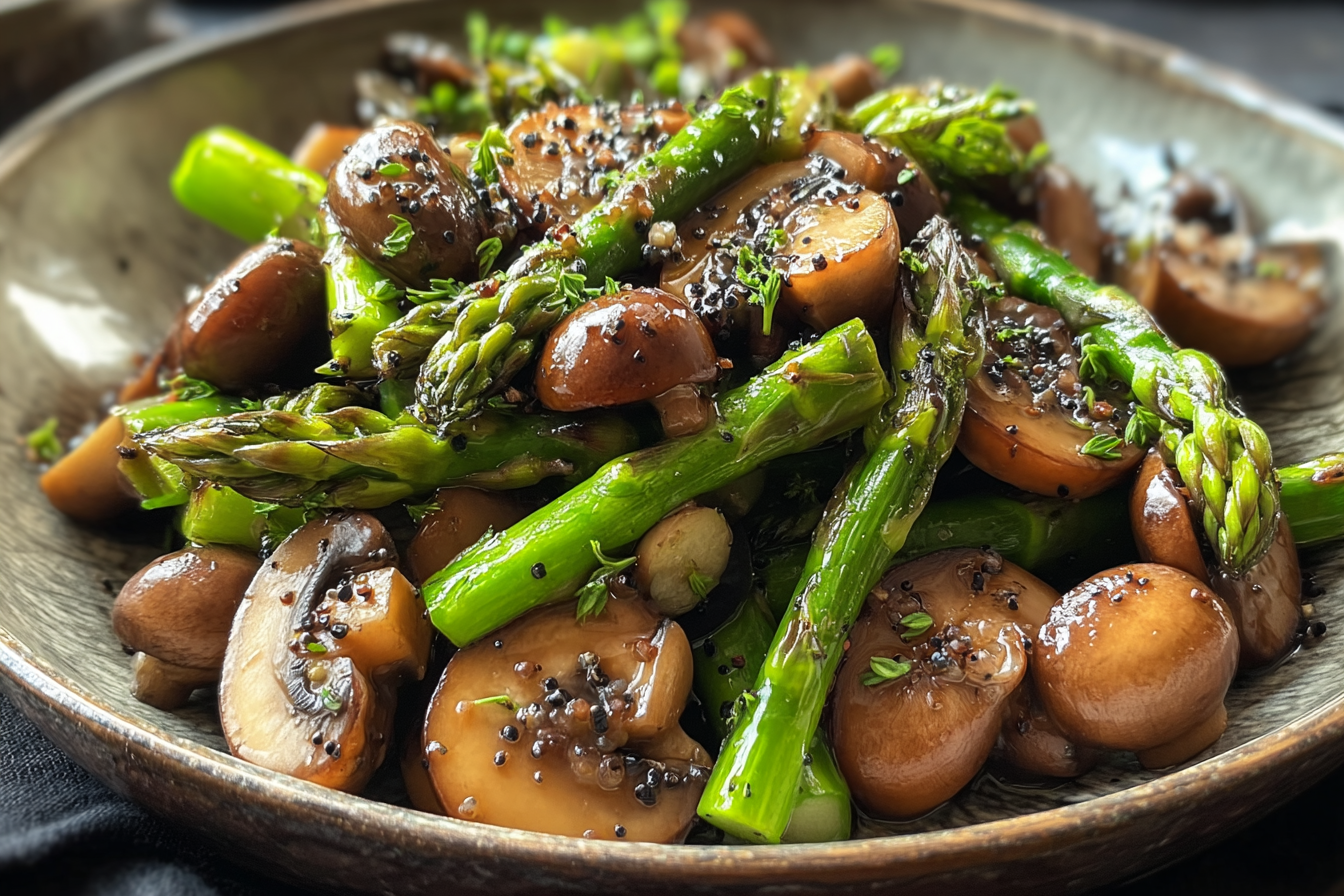Sautéed Asparagus and Mushrooms is one of those timeless, versatile side dishes that fits any table, any season, and practically any main course. This vibrant and nutritious duo delivers rich, earthy flavor from mushrooms and fresh, crisp texture from asparagus—all in under 10 minutes. Whether you’re serving steak, fish, or a vegetarian meal, this side dish will steal the spotlight.
This recipe has been a favorite among Cooking Flash readers, and it’s close to our hearts too. As shared on our About page, we believe great cooking doesn’t have to be complicated. Our journey started in a tiny apartment kitchen, with one skillet and zero fancy tools—just honest ingredients and the joy of creating delicious food. That same simple philosophy shines through this dish: garlic, asparagus, mushrooms, oil, salt, and pepper. That’s it. No fuss. Just flavor.
Looking for inspiration? Try our Garlic Butter Asparagus Orzo for another savory veggie combo!
Table of Contents
Table of Contents
Benefits of Sautéed Asparagus and Mushrooms
Nutritional Powerhouse: Why Asparagus and Mushrooms Are a Healthy Match
If you’re looking to add more vegetables to your meals without sacrificing flavor, sautéed asparagus and mushrooms is the way to go. Asparagus is rich in fiber, folate, and vitamins A, C, E, and K, while mushrooms pack a punch with antioxidants, selenium, and B vitamins. Together, they create a nutrient-rich side that’s naturally gluten-free and low in carbs.
According to the USDA, one cup of cooked asparagus has less than 30 calories, and mushrooms clock in at just about 20 calories per cup. That means you get a ton of volume, fiber, and satisfaction—without the guilt.
And let’s not forget fiber: asparagus aids digestion, while mushrooms contain beta-glucans that help lower cholesterol and boost immunity. The combo is especially great for plant-based eaters or anyone trying to lighten up their meals without losing depth of flavor.
Low-Calorie, High-Fiber Combo for Guilt-Free Eating
Let’s break it down with a quick table:
| Nutrient | Asparagus (1 cup) | Mushrooms (1 cup) |
|---|---|---|
| Calories | 27 | 21 |
| Dietary Fiber | 2.8g | 1.0g |
| Protein | 3g | 3g |
| Vitamin C | 12% DV | 2% DV |
| Antioxidants | High | Very High |
The beauty of this combo lies in its simplicity. It fills you up, fuels your body, and complements nearly every protein or grain you pair it with. Plus, it’s a great choice for those following keto, paleo, or Whole30 diets.
Check out Garlic Butter Mushroom Linguine for another veggie-packed idea.
Print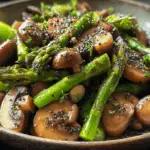
How to Make the Most Delicious Sautéed Asparagus and Mushrooms – Booyah!
- Prep Time: 5 minutes
- Cook Time: 7 minutes
- Total Time: 12 minutes
- Yield: 4 servings
- Category: Side Dish
- Method: Sautéed
- Cuisine: American
- Diet: Vegan
Description
This quick and easy sautéed asparagus and mushrooms dish is packed with earthy flavor and ready in under 15 minutes! Perfect as a healthy side, it’s seasoned simply with garlic, salt, and pepper for a naturally delicious veggie medley.
Ingredients
- 1 tablespoon vegetable oil (olive or avocado oil also work)
- 2 cloves garlic, minced
- 2 bunches asparagus, woody ends removed, cut into smaller pieces
- 8 oz button or cremini mushrooms
- 1/2 teaspoon kosher salt, or to taste
- 1/4 teaspoon black pepper
Instructions
- Heat oil in a large (12-inch) skillet over medium heat.
- Add minced garlic and sauté for 1 minute until fragrant.
- Add asparagus and mushrooms. Cook, stirring frequently, for 5–7 minutes, or until mushrooms release their juices and asparagus is tender.
- Season with salt and black pepper.
- Serve warm as a side dish.
Notes
- To boost flavor, sprinkle with grated Parmesan or a squeeze of lemon juice before serving.
- For added crunch, toss in toasted slivered almonds or pine nuts.
- Use a mix of mushroom varieties for more depth of flavor.
Nutrition
- Serving Size: 1 serving
- Calories: 80
- Sugar: 2 g
- Sodium: 250 mg
- Fat: 5 g
- Saturated Fat: 0.5 g
- Unsaturated Fat: 4.5 g
- Trans Fat: 0 g
- Carbohydrates: 7 g
- Fiber: 3 g
- Protein: 3 g
- Cholesterol: 0 mg
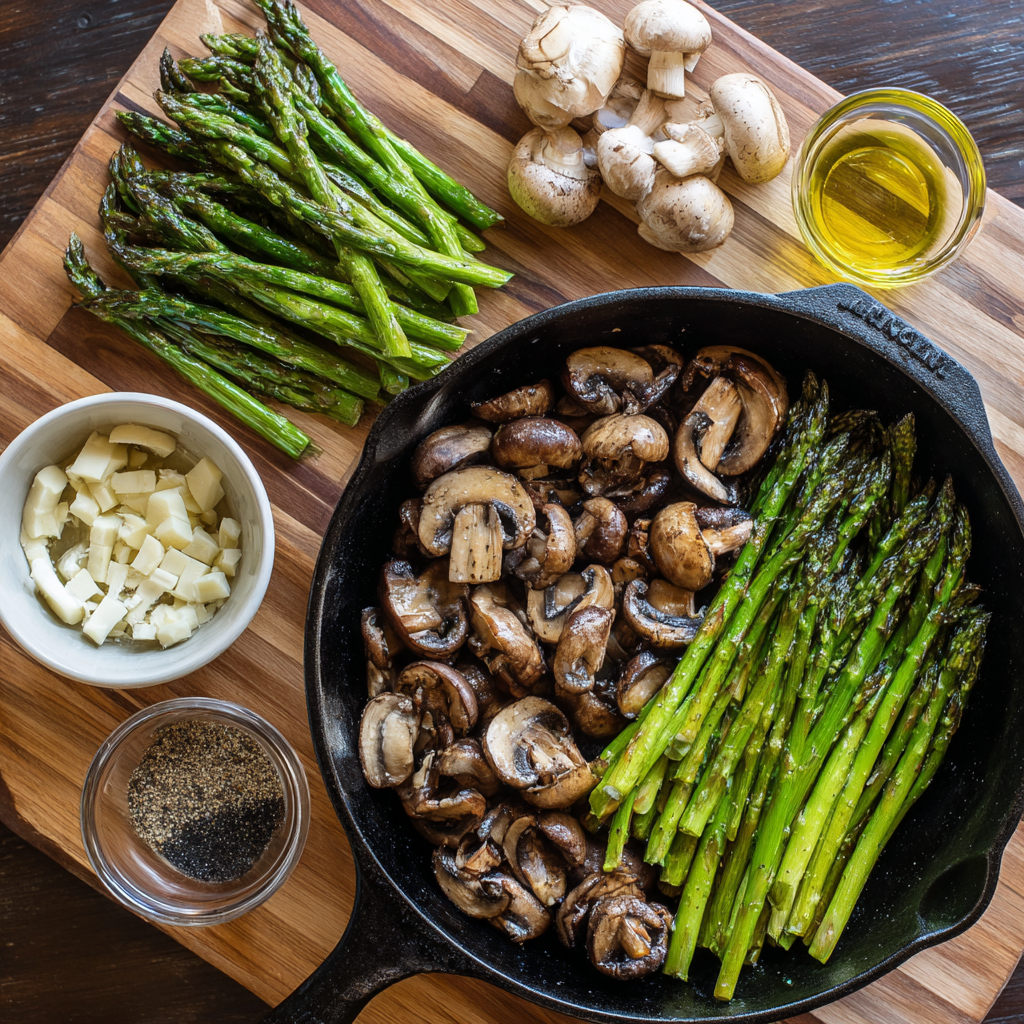
Must-Have Ingredients for Flavor-Packed Sautéed Asparagus and Mushrooms
Picking the Freshest Asparagus and Mushrooms for Maximum Taste for sauteed asparagus and mushrooms
When it comes to flavor, your ingredients are everything. The key to an incredible sautéed asparagus and mushrooms dish begins with smart produce choices. Let’s break down what to look for.
-
Asparagus:
Always go for stalks that are straight, firm, and vibrant green. The tips should be tightly closed, not mushy or frayed. Thin spears are especially great for sautéing because they cook fast and stay tender. Before cooking, snap or trim off the bottom inch or two—the woody part that tends to be tough and stringy. -
Mushrooms:
You can use either white button mushrooms or cremini mushrooms. Cremini (also called baby bellas) add a richer, earthier profile, while button mushrooms are lighter and a bit more neutral. Whatever you choose, the mushrooms should feel dry to the touch and free from any slimy coating or dark spots. Clean them gently with a damp cloth—never soak them in water, as that makes them soggy.
These two vegetables bring a great contrast: asparagus offers a crisp bite, while mushrooms deliver that meaty, umami flavor that fills the mouth. This makes the combo ideal as a stand-alone side or an add-in to pasta, grains, or stir-fry dishes.
Check out Crispy Golden Chicken with Creamy Parmesan Mushroom Sauce for another mushroom-inspired recipe.
Essential Flavor Boosters: Garlic, Oil, and Simple Seasoning
Even the best vegetables need a little help to shine. The beauty of this dish lies in how a few simple ingredients bring out the natural goodness of both asparagus and mushrooms.
-
Garlic (2 cloves, minced):
This little powerhouse turns up the flavor dial instantly. Just a minute or two of sautéing fresh garlic in oil gives the whole dish a warm, savory base. -
Cooking Oil (1 tablespoon):
Whether you use olive oil, vegetable oil, or avocado oil, each brings its own flavor profile:- Olive oil: adds a light, fruity richness
- Avocado oil: brings buttery notes and a higher smoke point
- Vegetable oil: neutral and budget-friendly
-
Salt (½ teaspoon kosher salt or to taste):
Salt isn’t just a flavor booster—it helps mushrooms release moisture so they can brown beautifully instead of steaming. -
Black Pepper (¼ teaspoon):
Just enough spice to add balance and warmth to every bite.
This no-fuss seasoning approach allows the vegetables’ natural flavors to take center stage. For an extra touch, try finishing with a splash of balsamic vinegar, a sprinkle of parmesan cheese, or even lemon zest if you’re serving it alongside seafood.
Looking for inspiration? Try Garlic Bread Grilled Cheese with this side for a cozy, satisfying meal.

How to Cook Sautéed Asparagus and Mushrooms Step-by-Step
Easy Vegetable Prep That Makes a Big Difference
Before you even turn on the stove, proper prep sets you up for success. Great sautéed asparagus and mushrooms starts with how you treat the ingredients from the start.
1. Preparing Asparagus for Sautéing
Start by rinsing your asparagus under cool water and patting it dry. Now comes the important part—getting rid of the tough ends. You can gently bend a stalk and it’ll snap exactly where the woody part ends. Use that as a guide to trim the rest. For quick, even cooking, chop the asparagus into 2-inch pieces. Thinner stalks work best for this method.
2. Getting Mushrooms Ready the Right Way
Mushrooms are delicate and absorb water easily. Instead of rinsing them under water, wipe each cap gently with a damp paper towel to clean off dirt. Slice the mushrooms evenly—about a quarter-inch thick works perfectly. If they’re smaller mushrooms, halving them adds a nice, chunky bite once sautéed.
Don’t miss our Garlic Butter Asparagus Orzo if you’re looking for more asparagus inspiration.
Sautéing Asparagus and Mushrooms Without Overthinking It
Once you’ve got your vegetables prepped and ready, the cooking part is as easy as it gets. With the right heat and timing, you’ll get beautifully browned mushrooms and perfectly tender asparagus every time.
Step 1: Warm the Oil and Infuse With Garlic for sauteed asparagus and mushrooms
Heat a 12-inch skillet over medium heat and pour in 1 tablespoon of your preferred oil—olive, avocado, or vegetable all work. Once hot, toss in 2 cloves of minced garlic. Stir gently for about a minute, just until the aroma fills your kitchen. Be careful not to brown the garlic—it turns bitter fast.
Step 2: Add the Asparagus and Mushrooms Together for sauteed asparagus and mushrooms
Add your cut asparagus and sliced mushrooms straight into the skillet. Stir well to coat everything in the garlicky oil. Cook for about 5 to 7 minutes, stirring occasionally. The mushrooms will release moisture at first, but keep going—they’ll begin to brown beautifully once that liquid cooks off.
Letting the mushrooms sit undisturbed between stirs gives them that irresistible golden edge—so don’t stir nonstop.
Step 3: Finish With Seasoning and Serve Fresh for sauteed asparagus and mushrooms
Once the asparagus is fork-tender and the mushrooms are golden brown, season the dish with ½ teaspoon kosher salt and ¼ teaspoon black pepper. Stir well to blend the flavors. Taste and adjust if needed.
Serve right away while it’s hot and full of flavor. This dish stands strong on its own or makes a great topper for pasta, rice, or even grilled chicken.
Check out Garlic Bread Sloppy Joes to pair with this veggie side for a quick dinner combo.

Pro-Level Cooking Tips for Sautéed Asparagus and Mushrooms That Wow
Should You Use Oil or Butter? Here’s What Makes the Difference
The fat you choose for cooking sautéed asparagus and mushrooms can change everything—from how your veggies brown to how they taste. Each option brings something unique to the table, and knowing when to use which makes you a smarter cook.
Why Oil Works Well for Searing
When sautéing over medium heat, oils like olive oil, avocado oil, and even canola oil offer stability and smooth flavor.
- Olive oil brings out a light earthiness that pairs well with garlic.
- Avocado oil is richer and buttery but handles heat like a champ.
- Canola or vegetable oil have a neutral flavor, letting your veggies stand out.
Oils are especially useful when you want a crisp texture without overwhelming the taste. If you’re serving the vegetables next to a bold protein—like roasted lamb or seasoned tofu—oil is the cleaner choice.
When Butter Adds That Golden Finish
Craving comfort food flavor? That’s where unsalted butter comes in. Butter offers a richness and depth that oil doesn’t, adding a subtle caramel tone to both asparagus and mushrooms as they cook.
But butter alone burns fast, so here’s a chef’s trick: combine butter with oil. You get the silkiness of butter and the high-heat tolerance of oil in one pan.
Craving cozy meals? Check out our Neiman Marcus Chicken Casserole for a creamy dish to serve with your veggies.
Sautéing Secrets: Avoid Mushy Veggies and Boring Flavor
Cooking this dish might seem simple, but a few common mistakes can turn crisp-tender into soggy and bland. These smart strategies will keep your sautéed veggies spot-on every time.
1. Don’t Pack the Skillet for sauteed asparagus and mushrooms
Want that golden color and crisp edges? Then give your vegetables room to breathe. Overcrowding traps steam, which makes mushrooms rubbery and asparagus limp. If your pan feels crowded, cook in two rounds. It’s worth it.
2. Keep an Eye on Your Heat for sauteed asparagus and mushrooms
Too low and you’re steaming. Too high and you’ll char the garlic before the veggies even get started. Medium heat offers the best control. Let the oil heat up before adding ingredients so everything sizzles on contact.
3. Choose the Right Pan for sauteed asparagus and mushrooms
A wide, heavy-bottomed skillet—like stainless steel or cast iron—is ideal. These pans distribute heat evenly and help the veggies brown instead of stick or stew. Avoid deep pots or small pans that trap steam.
Want to boost flavor even more? Try splashing a bit of balsamic vinegar or white wine into the pan after cooking. It lifts the caramelized bits off the skillet and adds an extra burst of brightness.
Check out our Garlic Bread Grilled Cheese for a satisfying pairing to your sautéed veggie side.
Mistakes to Avoid When Cooking Sautéed Asparagus and Mushrooms
Even the most straightforward dishes can go sideways with a few missteps—and sautéed asparagus and mushrooms are no exception. If your mushrooms are soggy or your asparagus lacks bite, you’re not alone. The good news? These slip-ups are easy to avoid with a few smart adjustments.
Avoid This: Crowding the Pan Too Much
One of the biggest errors home cooks make is cramming everything into the skillet at once. When mushrooms and asparagus are packed together tightly, they release moisture faster than it can evaporate. The result? Steamed vegetables instead of the golden, slightly crispy edges we want.
The fix: Use a large skillet and cook in batches if necessary. Give every piece some breathing room so it can brown properly, not steam.
Avoid This: Overcooking the Veggies Until They’re Mushy
Timing is everything. Asparagus cooks quickly—so does sliced mushroom. But if you keep the heat too low or leave them in the skillet too long, the texture turns soft and lifeless.
The fix: Stick to a medium-high heat and don’t walk away. Cook the dish for 5–7 minutes max, just until the asparagus is tender-crisp and the mushrooms are browned and juicy—not shriveled.
Looking for more veggie perfection? Don’t miss our Lazy Roasted Vegetables for an easy oven alternative.
Avoid This: Adding Salt Too Early
Salting mushrooms too early in the cooking process can draw out moisture before they’ve had a chance to brown. This leaves you with watery mushrooms that never get that savory sear.
The fix: Wait until the mushrooms begin to brown before adding salt. It allows them to caramelize first and keeps the skillet from flooding with liquid.
Avoid This: Forgetting to Taste and Adjust Seasoning
Sometimes the difference between a good dish and a great one comes down to a pinch more salt or a twist of black pepper. Don’t assume the first seasoning is enough—especially since mushrooms absorb flavor like sponges.
The fix: Taste just before serving. Add a pinch of flaky sea salt, a dash of fresh cracked pepper, or even a squeeze of lemon for that final flavor lift.
Discover great ideas like Crispy Veggie Potato Sticks with Cheese Sauce for another way to serve crowd-pleasing vegetables.
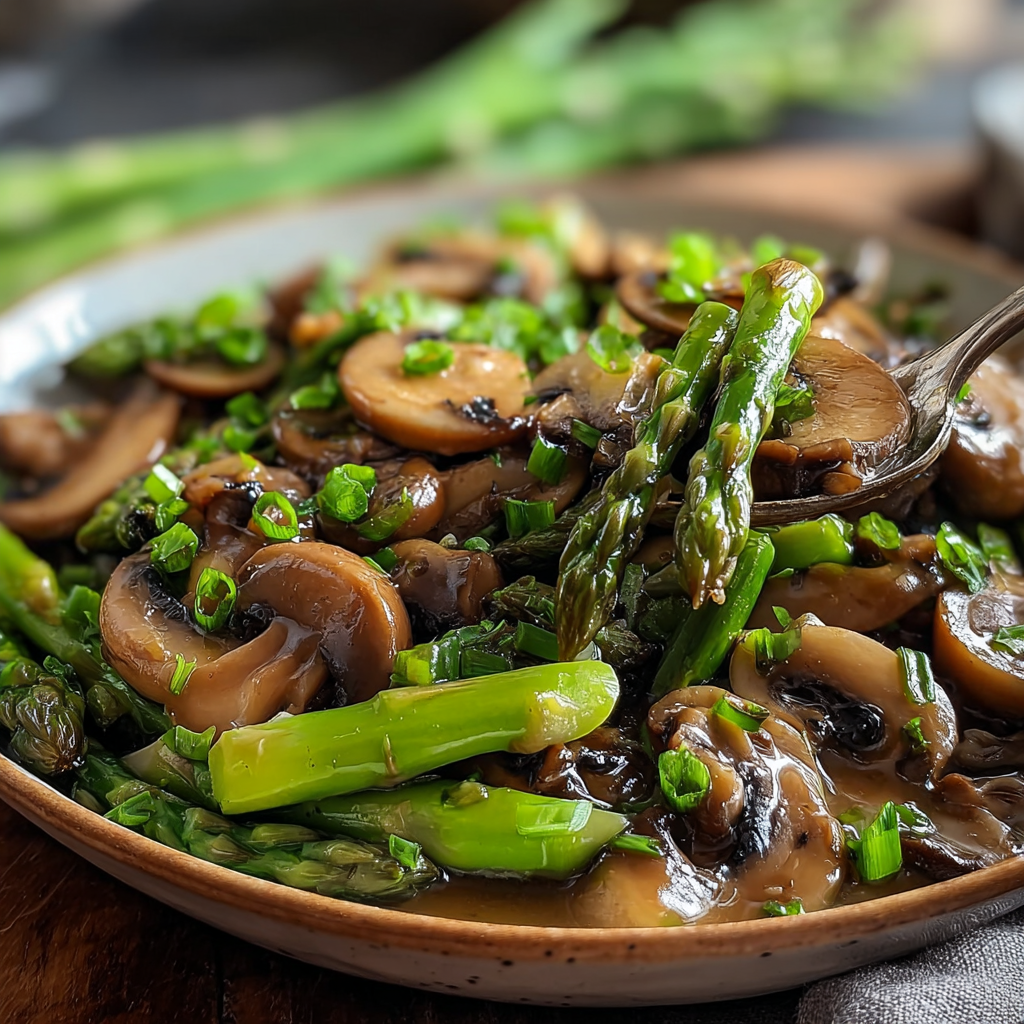
Creative Variations to Upgrade Your Sautéed Asparagus and Mushrooms
Classic sautéed asparagus and mushrooms is already a hit, but when you want to keep things exciting, a few tweaks can bring a whole new personality to the dish. Whether you’re craving something rich, spicy, tangy, or fusion-style, these variation ideas will breathe new life into your skillet veggies.
Butter or Olive Oil – Which One Brings Out More Flavor?
Choosing the right fat can seriously impact how your vegetables taste and feel in your mouth.
Why Choose Butter
Butter gives mushrooms a richer, more luxurious taste. It enhances the savory side of the dish and adds a soft, creamy finish that coats the asparagus just right. It’s a favorite for comfort-style meals or colder seasons.
Why Go with Olive Oil
On the flip side, olive oil brings a cleaner, more herbaceous quality to the dish. It highlights the freshness of the asparagus and allows the mushrooms’ natural depth to come forward without being overly heavy. This is great for lighter meals or heart-healthy plates.
Pro tip: Combine both—start your sauté with olive oil, and stir in a pat of butter at the end to finish with a silky touch.
Want to pair this with a bold entrée? Check out our Crispy Golden Chicken with Creamy Parmesan Mushroom Sauce for the ultimate dinner plate.
Intensify the Garlic Factor for a Bold Flavor Kick
Garlic already plays a central role in the recipe, but if you’re a garlic fanatic, there’s no reason to hold back.
- Add a third garlic clove or even roasted garlic for depth
- Stir in garlic powder near the end for extra punch
- Swap regular oil for garlic-infused oil
- Garnish with crispy garlic chips for crunch and flavor
This version pairs perfectly with grilled steak, chicken, or a bed of creamy polenta.
Roasted Variation: Oven-Baked Asparagus and Mushrooms
If you’d rather use your oven than hover over a hot skillet, roasting is a great hands-off method. It produces a slightly different texture—more caramelized edges and a deeper umami.
How to do it:
- Preheat to 425°F
- Toss the vegetables in oil, minced garlic, salt, and pepper
- Spread evenly on a parchment-lined sheet pan
- Roast for 15–20 minutes, flipping halfway through
Roasted asparagus and mushrooms hold their own next to hearty mains or can be tossed into grain bowls for a satisfying lunch.
Try our Savory Garlic Butter Steak Bites with Parmesan Sauce alongside this roasted twist for a full-flavor meal.
Simple Add-Ins to Change the Game
Want to dress your veggies up without overcomplicating things? These add-ons bring huge impact with minimal effort:
- Balsamic Vinegar or Reduction: A drizzle adds sweetness and acidity
- Lemon Zest or Juice: Great for balance and brightness
- Shaved Parmesan or Crumbled Goat Cheese: Adds creaminess and contrast
- Red Pepper Flakes or Cayenne: For heat lovers
- Toasted Nuts: Almonds or pine nuts add crunch and richness
- Fresh Herbs: Think thyme, parsley, or chives for a fresh finish
You can even build this dish into a full entrée by stirring in some cooked pasta, rice, or quinoa.
Looking for casserole inspiration? Don’t miss our creamy classic Neiman Marcus Chicken Casserole to match these veggie upgrades.
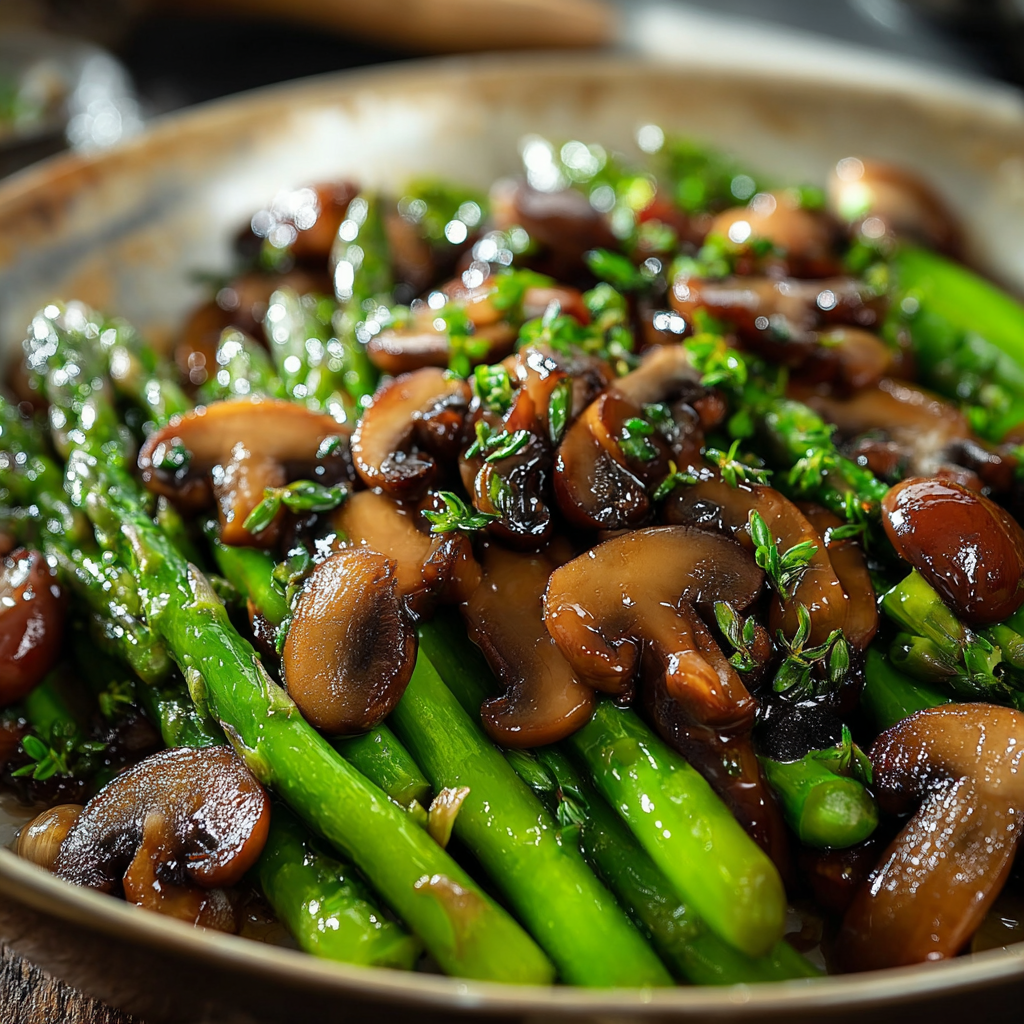
How to Serve Sautéed Asparagus and Mushrooms – Pairings & Meal Ideas
Once your skillet is sizzling with perfectly cooked sautéed asparagus and mushrooms, the next question is—what do you serve it with? The great news is this dish is incredibly adaptable. Whether you’re planning a weeknight dinner or a weekend brunch, there are tons of delicious ways to enjoy and reimagine this vegetable combo.
Best Dishes to Serve Alongside Asparagus and Mushrooms
This side doesn’t steal the show—but it absolutely enhances it. From grilled meat to baked seafood, here are smart pairings to round out a full plate:
1. With Meat-Based Mains for sauteed asparagus and mushrooms
The earthy tones from mushrooms and the freshness of asparagus work great with protein-forward dishes:
- Grilled chicken breast or thighs
- Garlic-rubbed ribeye steak
- Pork tenderloin or glazed chops
- Beef roasts or short ribs
This veggie duo soaks up sauces and complements bold flavors beautifully.
2. With Seafood for sauteed asparagus and mushrooms
For lighter meals, this sautéed side pairs wonderfully with:
- Seared salmon or trout
- Garlic shrimp skewers
- Lemon butter cod
A squeeze of lemon over the whole plate pulls everything together.
Looking for inspiration? Try our Ultimate Shrimp Cheese Toast with Garlic Bread as a fun seafood match.
Turn Your Veggies Into a Main Dish
Who says this dish has to stay on the sidelines? Add a few ingredients and you’ve got a full, balanced meal:
- Toss with linguine or penne and finish with grated parmesan
- Layer over a bowl of rice or quinoa with tahini drizzle
- Add a sunny-side-up egg and serve over toast or polenta
- Stuff into pita bread with a spread of tzatziki or goat cheese
- Mix into scrambled eggs or a frittata for brunch-ready flavor
The textures and flavors work well in both hot and cold applications—perfect for meal prepping or quick lunches.
Don’t miss our comforting Hearty Chicken Mushroom Alfredo to see how mushrooms and asparagus shine in creamy pasta dishes.
Creative Ways to Use Leftovers Without Boredom
Cooked a big batch? No problem. This dish stores well in the fridge and lends itself to all kinds of next-day makeovers.
Try these leftover makeovers:
- Chop and stir into a warm pasta salad
- Add to a grilled cheese or veggie melt
- Toss into a breakfast burrito
- Mix into creamy risotto or baked mac and cheese
- Serve cold with balsamic glaze over arugula for a light lunch
Store in an airtight container for up to 3 days. To reheat, use a skillet over low heat or pop it in the microwave for 30–45 seconds.
Need a cheesy way to use leftover mushrooms? Explore our Cheesy Taco Potatoes for a comfort-packed side that’s perfect for repurposing.If you’re turning your sautéed veggies into a seafood feast, pair them with these creamy, savory** Spinach Mushroom Shrimp Shells.** It’s rich, balanced, and ideal for guests.
Final Thoughts – Why Sautéed Asparagus and Mushrooms Deserve a Spot on Your Table
By now, you’ve seen just how flexible, flavorful, and foolproof sautéed asparagus and mushrooms can be. Whether you’re whipping up a fast side dish for weeknight dinner or building a cozy brunch plate, this dish hits every mark—quick, nutritious, and endlessly customizable.
We explored everything from choosing the right oil or butter to roasting options and even how to turn leftovers into full meals. You’ve learned:
- How to cook asparagus and mushrooms together in just one pan
- What mistakes to avoid for better texture and taste
- Ways to flavor it up with garlic, balsamic, lemon, and more
- How to make it a meal with pasta, rice, or eggs
- How to store and repurpose leftovers with ease
At its heart, this is a back-pocket recipe—one you’ll reach for again and again. It’s simple, yet satisfying. Elegant, yet effortless. And most of all, it’s the kind of dish that works with what you already have in your fridge.
Looking for your next vegetable dish? Check out our Lazy Roasted Vegetables or dig into something rich like the Neiman Marcus Chicken Casserole.
Thanks for reading this recipes for sauteed asparagus and mushrooms , and happy sautéing!
Can I sauté mushrooms and asparagus together?
Yes, absolutely. In fact, sautéing mushrooms and asparagus in the same skillet is one of the best ways to blend their flavors. Both vegetables cook quickly and pair beautifully when sautéed in garlic and oil. Start them at the same time and cook over medium heat for 5–7 minutes, stirring occasionally. Mushrooms will release their juices and brown, while asparagus turns bright green and tender-crisp.
Should I boil asparagus before sauteing?
No, there’s no need to boil asparagus before sautéing. In fact, skipping the boiling step keeps the asparagus from becoming mushy. Sautéing over medium heat with a little oil allows it to retain its crisp texture and vibrant color. Just make sure to cut off the woody ends and slice the stalks into smaller pieces for even cooking.
Is it better to sauté mushrooms in oil or butter?
Both oil and butter work well, and each has its own advantage. Oil (like olive or avocado) is great for high-heat cooking and keeps the dish light. Butter adds rich, savory flavor and gives mushrooms a golden, glossy finish. For the best of both worlds, start with oil and stir in a small amount of butter near the end of cooking.
Can you sauté raw asparagus?
Yes, you can sauté raw asparagus—and you should. There’s no need to pre-cook it. When sautéed fresh, asparagus retains its snap and flavor. Simply slice it into manageable pieces, heat some oil or butter, and cook it in the skillet along with other ingredients like mushrooms or garlic. It takes just a few minutes to become tender without losing its natural crunch.
How long does it take to cook asparagus and mushrooms together?
It typically takes about 5 to 7 minutes over medium heat to cook asparagus and mushrooms in the same pan. The mushrooms will start to brown and shrink as they release moisture, and the asparagus should become fork-tender with a slight crispness. For deeper caramelization, you can extend cooking to 8 minutes, stirring less often.
What’s the best way to store leftovers?
Store leftover sautéed asparagus and mushrooms in an airtight container in the refrigerator. They’ll stay fresh for up to 3 days. To reheat, use a skillet over low heat or microwave in short bursts to maintain texture. You can also enjoy the leftovers cold in salads, wraps, or grain bowls.
Looking for a veggie-packed side that reheats well? Try our Garlic Mozzarella Margherita Pasta for a delicious option that complements leftovers.

